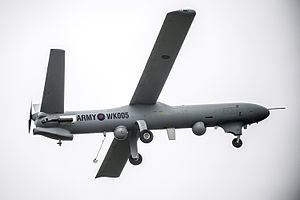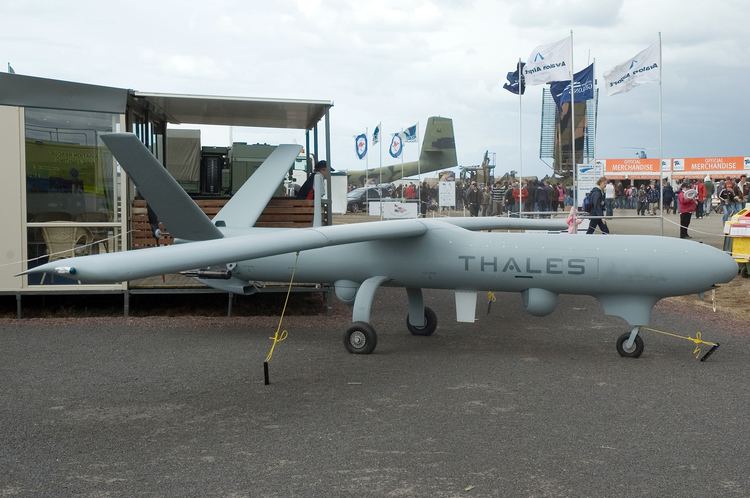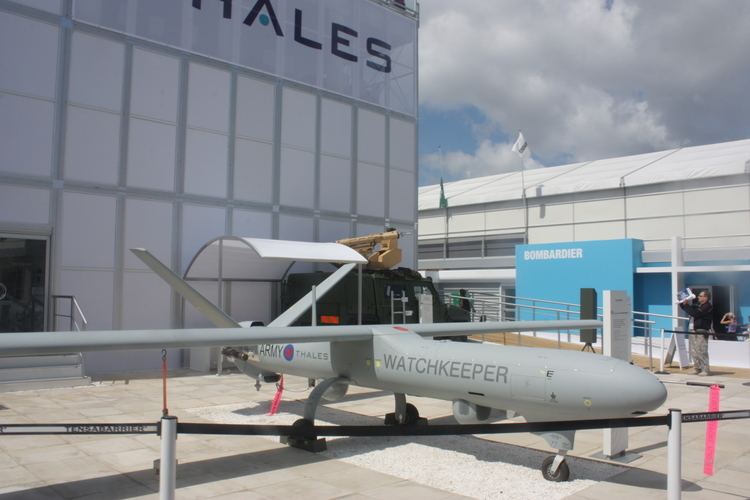First flight April 14, 2010 | ||
 | ||
British army s thales watchkeeper wk450 uav in afghanistan
The Thales Watchkeeper WK450 is a Remotely Piloted Air System (RPAS) for all weather, intelligence, surveillance, target acquisition, and reconnaissance (ISTAR) use by the British Army. It is provided under an £800 million contract from Elbit and Thales UK and is based on Elbit's Hermes 450.
Contents
- British army s thales watchkeeper wk450 uav in afghanistan
- Thales watchkeeper wk450 uav
- Overview
- History
- Deployment
- References

Thales watchkeeper wk450 uav
Overview

The Watchkeeper WK450 is based on the Elbit Hermes 450 UAV and is built in the UK by a joint venture company, UAV Tactical Systems (U-TacS), set up by the Israeli company Elbit Systems (51% ownership) and the Thales group. It has a mass of 450 kg, a typical endurance of 17 hours, a payload capacity of 150 kg and uses a rotary Wankel engine provided by UAV Engines Ltd, a wholly owned subsidiary of Elbit Systems. It can operate up to 150 km from the Ground Control Station (although multiple stations can be linked to extend the range). It was originally intended to enter service in June 2010, but years of delays, technical issues, hardware modifications, difficulties in training sufficient pilots and incidents means that it is not expected to be fully operational until late 2017.

A prime difference between the Hermes 450 and Watchkeeper is that the 450 is fitted only with an electro-optical/infrared sensor, while the WK450 has in addition a dual-mode synthetic aperture radar and ground moving target indication system that allows it to see through all weather conditions. The British Army will receive 30 Watchkeepers and a further 24 machines due to go into store to be pulled into service as needed.
History

On 15 July 2007, the UK MoD revealed that 54 Watchkeepers will be delivered to the British Army. The average cost to the taxpayer is therefore £800m divided by 54 aircraft, approximately £15m per platform. However, this figure includes construction of new basing facilities at Boscombe Down airfield, ground training facilities and simulators at the School of Artillery, ground control stations, development and testing of extensive aircraft modifications including automatic take-off and landing and the integration and provision of new sensors including radars.

Watchkeeper's first UK flight took place on Wednesday 14 April 2010 from ParcAberporth in Wales, but due to numerous delays the delivery date slipped,. By 2014 Watchkeeper had gained certification from the Military Aviation Authority, had its Release to Service granted was cleared for military flight training with the Royal Artillery, operating out of Boscombe Down in Wiltshire. In February 2014, the French Ministry of Defence indicated that the French Army may purchase the Watchkeeper WK450, but they instead selected the Sagem Patroller for the tactical unmanned air vehicle requirement.
By December 2015 delivery to the British Army was progressing well, but there was difficulties in training sufficient pilots. As poor weather in Britain was limiting the time available to conduct flying training the decision was made to conduct future training on the tropical Ascension Island located in the Atlantic Ocean. Although there is hope that future modifications to the aircraft will enable it to fly in poor weather, the training on Ascension Island is set to continue for the foreseeable future. Enough pilots and ground crew are expected to be trained for full operational capability to be reached by early 2018.
Deployment
On 29 September 2014, the MoD revealed that an undisclosed number of Watchkeepers had become fully operational and sent to Afghanistan. The aircraft were stationed at Camp Bastion to provide force protection for British troops and worked alongside Hermes 450s that it is derived from. Watchkeeper proved its use by successfully supported a detachment of U.S. Marines using its Thales I-Master radar. It cued a Hermes 450 onto a target for continued tracking, which then passed the information on to a Royal Air Force MQ-9 Reaper to conduct an airstrike. Some 140 flights were conducted for 8 hours a day until operations ceased in mid-October 2014.
